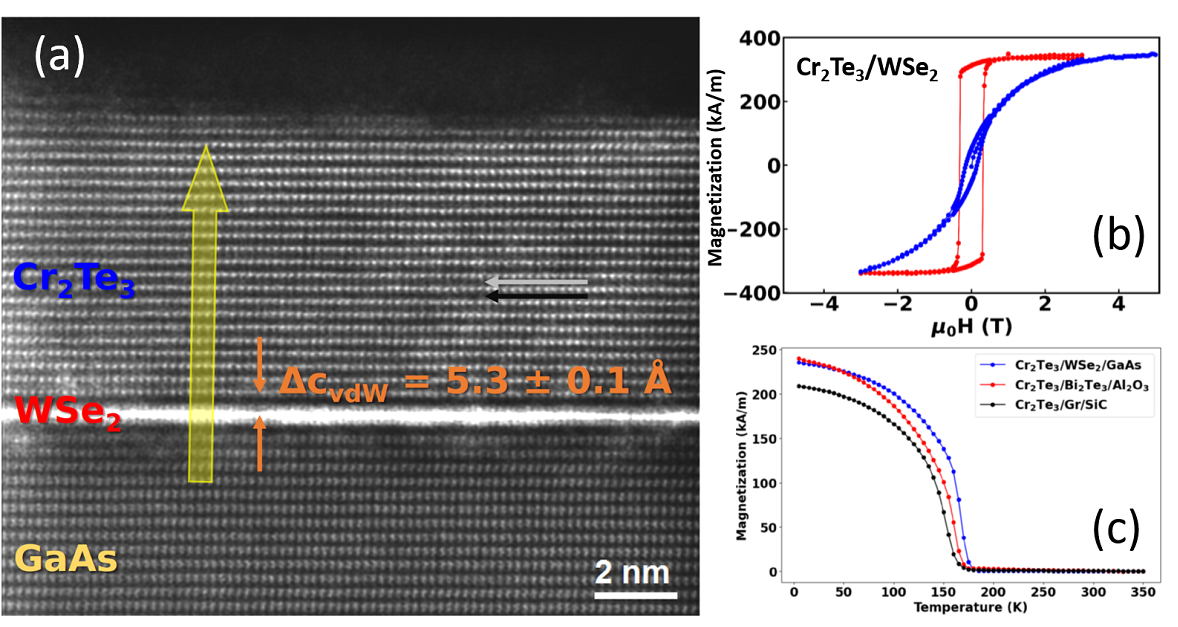For the future integration of 2D materials in spintronic devices (sensors, memories…), the ability to grow van der Waals (vdW) heterostructures combining 2D magnets, high mobility, high spin-orbit coupling (SOC) or topological materials on large areas constitutes a real challenge today. Here, by using molecular beam epitaxy in the van der Waals regime, we could grow high crystalline quality vdW heterostructures with sharp interfaces and well defined magnetic and magnetotransport properties in agreement with by ab initio calculations.
Achieving large-scale growth of two-dimensional (2D) ferromagnetic materials with high Curie temperature (TC) and perpendicular magnetic anisotropy (PMA) is highly desirable for the development of ultra-compact magnetic sensors and magnetic memories. In this context, van der Waals (vdW) Cr2Te3 appears as a promising candidate. Bulk Cr2Te3 exhibits strong PMA and a TC of 180 K. Moreover, both PMA and TC might be adjusted in ultrathin films down to the monolayer by engineering composition, strain, or applying an electric field. In this work, we demonstrate the molecular beam epitaxy (MBE) growth of vdW heterostructures of five-monolayer quasi-freestanding Cr2Te3 on three classes of 2D materials: graphene (high mobility semimetal), WSe2 (high SOC semiconductor) and Bi2Te3 (topological insulator).

(a) Transmission Electron Microscopy image in cross section showing the Cr2Te3/WSe2(1ML)/GaAs van der Waals heterostructure. (b) Out-of-plane (red) and in-plane (blue) hysteresis curves recorded by SQUID showing the strong PMA. (c) Remanence curves of the three vdW heterostructures.
By combining structural and chemical analysis down to the atomic level with ab initio calculations, we confirm the single crystalline character of Cr2Te3 films on the 2D materials with sharp vdW interfaces (see Fig. 1a). They all exhibit PMA (Fig. 1b) and TC close to the bulk Cr2Te3 value of 180 K (Fig. 1c). Ab initio calculations confirm this PMA and show how its strength depends on strain. Finally, from Hall measurements, we revealed a strong anomalous Hall effect, which changes sign at a given temperature. We theoretically explain this effect by a sign change of the Berry phase close to the Fermi level. This transition temperature depends on the 2D material in proximity, notably as a consequence of charge transfer.
MBE-grown Cr2Te3/2D material bilayers constitute model systems for the further development of spintronic devices combining PMA, large spin-orbit coupling and sharp vdW interface.
Teams: 2D spintronics, Theory & simulation
Collaboration: IRIG-MEM, IRIG-PHELIQS, IRIG-SYMMES, Synchrotron SOLEIL, C2N, Inst. NEEL
Funding: ESR/EQUIPEX+ ANR-21-ESRE-0025 2D-MAG, EU Graphene Flagship
Further reading: Epitaxial van der Waals heterostructures of Cr2Te3 on 2D materials, Q. Guillet, L. Vojacek, D. Dosenovic, F. Ibrahim, H. Boukari, J. Li, F. Choueikani, Ph. Ohresser, A. Ouerghi, F. Mesple, V. Renard, J.-F. Jacquot, D. Jalabert, H. Okuno, M. Chshiev, C. Vergnaud, F. Bonell, A. Marty and M. Jamet Phys. Rev. Mater. 7, 054005 (2023), hal-04017966
Contacts: Matthieu JAMET, Mairbek CHSHIEV




